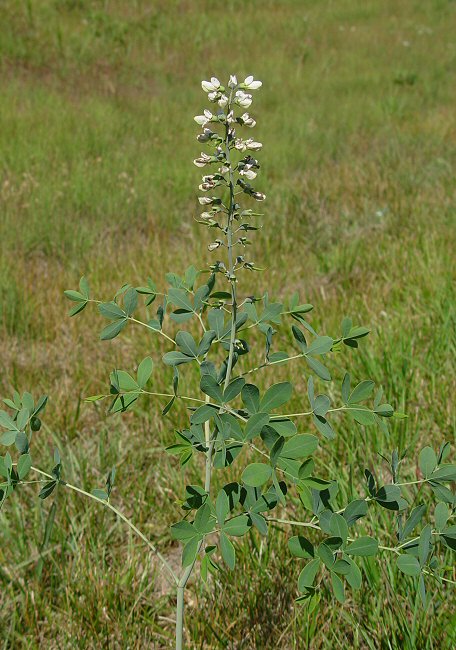Baptisia alba (L.) R. Br.
White Wild Indigo

Native
CC = 6
CW = 3
MOC = 65
© DETenaglia
Baptisia alba (L.) R. Br.White Wild Indigo | |
 |
Native CC = 6 CW = 3 MOC = 65 |
© DETenaglia |
|
Family - Fabaceae/Faboideae Habit - Perennial forb, deeply rooted with thick, woody rhizomes and woody crown. Plants blackening on drying. Stem - Erect, to 2 m, stout, glabrous, glaucous, finely ribbed, with ascending branches.
Leaves - Trifoliate, petiolate, stipulate, glabrous. Petioles 4-25 mm long. Stipules 5-25 mm long, lanceolate to narrowly ovate, mostly shed early. Leaflets 2-6 cm long, oblanceolate to obovate or elliptic, rounded to bluntly or broadly pointed at the tips, with single midvein.
Inflorescences - Elongate terminal racemes to 60 cm, with numerous flowers, on stalks to 12 cm. Bracts 6-14 mm long, lanceolate to narrowly ovate, early deciduous.
Calyces - Calyces with the tube bell-shaped, 5-7 mm long, appearing 4-lobed, the lobes 2-3 mm long, the margins and inner surface finely white-hairy.
Flowers - Corollas papilionaceous, white, the banner 12-18 mm long, 10-16 mm wide, the wings 18-23 mm long, 4-7 mm wide, the keel 18-23 mm long, 5-8 mm wide. Stamens 10, similar in length, the filaments free, 13-21 mm long, the anthers 1.2-1.4 mm long. Ovary short-stalked, 10-12 mm long, glabrous, the style curved, glabrous, 5-7 mm long, the basal portion persistent at fruiting. Stigma minute, terminal.
Fruits - Legumes 2.0-3.5 cm long, 1.0-1.5 cm broad, cylindric to ellipsoid, sometimes asymmetrically so, strongly inflated, straight, tardily dehiscent, tapered to a stalklike base 10-12 mm long, tapered abruptly to the beak, this 5-7 mm long, hairlike nearly throughout, the walls relatively thin and brittle, glabrous and black at maturity. Seeds 4-5 mm long, 2.6-3.0 mm wide, greenish brown to yellowish brown with warty, resinous dots.
Flowering - May - July. Habitat - Prairies, savannas, glades, forest openings, bluffs, railroads, roadsides. Origin - Native to the U.S. Lookalikes - When flowering the plant is not easily mistaken for anything else. Vegetatively it is easy to confuse with other members of the genus. The fruits of this species are unique among the Missouri species of Baptisia in being sharply truncate at the distal end. Fruits of the other common species have ends which are tapered.
Other info. - This very recognizable species is found throughout most of Missouri, except for the Mississippi Lowlands, and across the U.S. Midwest. It is an attractive plant and is sometimes cultivated. The genus name comes from the Greek word "bapto," which means "to dye," because some of the darker flowered species were used as dyes. In the past the plant was known as B. leucantha and other names. Missouri plants are assignable to var. macrophylla. Photographs taken at Bethel Prairie, Barton County, MO., 7-4-03, and off Hwy 19, Shannon County, MO., 6-12-05 (DETenaglia); also near Gray Summit, Franklin County, MO, 6-25-2017 (SRTurner). |